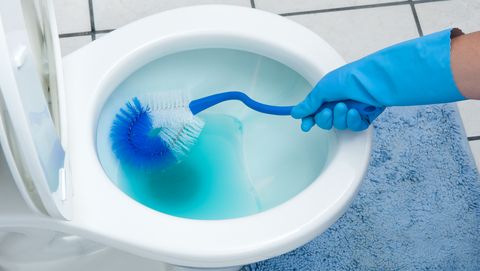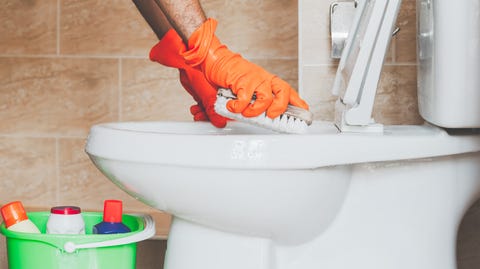Believe it or not, our toilets actually can be one of the cleaner things in our bathrooms; according to a 2011 study conducted by NSF International, our toothbrush holders can host the highest amount of viral bacteria, germs, and mold in our bathroom. But 27% of the toilet seats involved in the study (as well as 14% of toilet handles) contained alarmingly high amounts of mold, yeast, and germs, which illustrates that many people aren’t cleaning their toilets correctly. While you may clean or wipe down your toilet often, the best way to remove germs and viruses is to actually disinfect it.
Carolyn Forte, the director of the Good Housekeeping Institute Cleaning Lab, says that many people neglect reading the instructions on their cleaning products — and don’t realize that they need to leave toilet surfaces wet with cleaner for a certain amount of time to kill germs entirely. “Yes, a product can claim that it kills 99% of germs and bacteria. But it needs to stay wet to be effective, and if you’re using it for a matter of seconds, it’s not going to be effective,” Forte explains.
Charles Gerba, Ph.D., a professor of epidemiology and bio-statistics in the Department of Environmental Science at the University of Arizona, found that a single flush could send E. coli bacteria into the air (and onto the toilet itself) where they can float in the airstream for up to six hours, in research published in the journal Applied Microbiology. The research notes that it’s unclear if this airborne bacteria could pose the same risk as other sources of germs, but Gerba tells Good Housekeeping that viruses in general can live on surfaces like your toilet anywhere from a few hours to a few days. “Most cold and flu viruses survive from a few hours to up to 9 days, [depending] on temperature and relative humidity,” he says.
Below, Forte shares her advice for disinfecting all of the dirtiest surfaces on a toilet, plus a few tips to keep the rest of your bathroom as clean as possible.
How do you properly clean a toilet?
Before you get started, you’ll need to be well equipped for the job. Forte says that she recommends people keep a separate set of cleaning tools that aren’t used on other surfaces across the home. While she says there are a multitude of bathroom cleaners that homeowners can use, she recommends the following list of supplies based on each product’s clear instructions that state time limits for proper disinfecting of toilet surfaces.
- A bristle scrubbing brush (can be stored in a separate holder in your bathroom)
- A pair of rubber gloves
- One or two Brillo-pad-enhanced sponges
- A gallon of Clorox bleach, regular variety (can be used across the home)
- A bottle of Clorox Toilet Bowl Cleaner With Bleach
- A pack of disinfecting wipes of your choice
- A bottle of Lysol Power Bathroom Cleaner
How do you clean a stained toilet bowl?
When you clean your toilet, you should always start with the bowl first, Forte says. You can use products that are marketed to clean and disinfect germs in the toilet bowl, but Forte recommends picking up a bottle of Clorox’s toilet bowl cleaner that’s loaded with bleach, as the product claims it can disinfect the inside of the toilet in just five minutes. Using the Clorox product, Forte says you should coat the entirety of your toilet bowl starting underneath the seat’s rim: Then, put on your gloves and use your toilet brush to physically scrub the solution into your toilet bowl. “Be sure to scrub well with the cleaner around the inside of your bowl, the toilet bend if possible, and underneath the rim of the bowl,” she explains. “Then, you’ll want to let everything sit for five minutes, and flush it all away.”
If you don’t have access to a specific toilet bowl disinfectant, the next best thing is actual bleach itself, Forte says. Simply measure out half a cup’s worth of bleach and use your toilet brush to scrub it into the bowl and beneath the seat’s rim, also allowing five minutes to pass before you flush it all away.
A step-by-step guide to disinfecting the toilet:
While you are waiting for your toilet bowl cleaner to properly disinfect, you can get started on cleaning the rest of the commode. Use a bathroom-specific disinfectant: Forte recommends Lysol’s Power Bathroom Cleaner because it clearly states how long you’ll need to leave the surface wet in order to neutralize common viruses and bacteria: 10 minutes.
An Important Note: Forte says that disinfectants only truly neutralize germs if the surface has been pre-cleaned of any surface scum or debris beforehand. This means you’ll need to pass over your toilet once quickly with a disinfecting wipe before actually applying a spray product. You’ll need to remove any bodily fluids, such as vomit, before applying your disinfectant spray for it to be truly effective, Forte says.
- Start with the exterior of your toilet. You can work your way up from its foundation to the lid itself. Spray underneath your toilet thoroughly and don’t worry if the cleaner drips down the side of your toilet, Forte says. Be sure to spray the small area between the toilet seat and the tank, and work your way up the tank and on top of the tank itself.
- Then spray down both sides of the lid, starting with the exterior, as you’ll need to leave the lid up to reapply spray if necessary.
- Next, spray both sides of the toilet seat thoroughly, and lower it back on top of the bowl once you’ve finished.
- While you are waiting for the disinfectant to air dry, tackle tough spots that are known to harbor more germs. Case in point: The toilet’s flush handle, which can be even dirtier than the actual seat itself, according to the NSF International study. Using a disinfectant wipe, vigorously wipe and rub the handle down, and be sure that it’s wet for at least five minutes before it air dries.
After 10 minutes have passed, grab a clean sponge or clean paper towels to wipe away any condensation, ensuring that every surface is dry. Plus, don’t forget to flush your toilet if you haven’t already!
How often should I clean my toilet?
Disinfecting your toilet can help reduce the risk of coming into contact with threatening germs in your home, especially if someone in your family is sick and can’t be quarantined in their own quarters. But it’s important to understand that even after just one use, the toilet could once again play host to bacteria and viruses on its surfaces.
Forte says you should try to clean your toilet as often as possible, but that a full disinfect should take place every two to three days if someone is sick in your home. Outside of flu season, once a week — or biweekly, depending on how frequently the toilet is used — should suffice.
While you don’t have to worry about it every time you sanitize or disinfect your toilet, Forte says you should also factor in time to actually disinfect your cleaning supplies as well. A toilet scrubbing brush can grow mold on its own if it’s left in a watery holder, so Forte says you should periodically clean it after you’ve finished scrubbing the toilet bowl and surfaces. Spray it thoroughly with a disinfectant spray, and let it air dry by placing it between your toilet seat and the bowl itself (allowing the scrubbing head to hang above the water in the bowl). For your gloves, sponges, or any other rubber-based or porous cleaning supplies, you can make sure they’re germ-free by soaking them in bleach-infused water and air-drying afterwards.
Source: Home Ideas - goodhousekeeping.com







